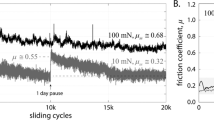Abstract
Tribological properties of bulk metallic glass Zr41.2Ti13.8Cu12.5Ni10.0Be22.5 were studied experimentally using a pin/disk geometry without lubrication. Experimental observations were compared with 2D molecular dynamics simulations of amorphous material in sliding contact. The friction coefficient and the wear rate of bulk metallic glass (BMG) depend on normal load and test environment. The sliding of annealed BMG re-amorphizes devitrified material. A mechanically mixed layer is generated during sliding; this layer has enhanced oxygen content if the sliding is in air. The MD simulations show that atomic scale mixing occurs across the sliding interface. The growth kinetics of the mixing process scales with the square root of time. In the simulations, a low density region is generated near the sliding interface; it corresponds spatially to the softer layer detected in experiments. Subsurface displacement profiles produced by sliding and by simulation are very similar and are consistent with the flow patterns expected from a simple Navier-Stokes analysis when the stress state involves both compression and shear.
Similar content being viewed by others
References
W. L. Johnson, MRS Bulletin 24, 42–56 (1999).
A. Inoue, Acta Mater. 48, 279–306 (2000).
P. J. Blau, Int’l. Conf. Wear of Materials 2001 and to be published in Wear (2001).
F. P. Bowden and D. Tabor, The Friction and Lubrication of Solids (Oxford University Press, Oxford, 1964), vol. 2.
A. Sagel, H. Sieber, H.-J. Fecht and J. H. Perepezko, Acta Mater. 46, 4233–4241 (1998).
A. Calka and A. P. Radlinski, Materials Science and Engineering A118, 131–135 (1989).
C. C. Koch, Deformation and Fracture of Amorphous, Nanocrystalline and Amorphous / Nano-crystalline materials, Y.-W. Chung, D. C. Dunand, P. K. Liaw, G. B. Olson, Eds., Advanced Materials for the 21st Century: The 1999 Julia R. Weertman Symposium (The Minerals, Metals & Materials Society, 1999).
F. Lancon, L. Billard and P. Chaudhari, Europhys. Lett. 2, 625–629 (1986).
X.-Y. Fu, M. L. Falk and D. A. Rigney, Int’l. Conf. Wear of Materials 2001 and to be published in Wear (2001).
D. A. Rigney, Wear 245, 1–9 (2000).
D. A. Rigney, Mat Res Innovat. 1, 231–234 (1998).
W. M. Rainforth, Wear 245, 162–177 (2000).
A. Argon, Acta Met. 27, 47–58 (1979).
Author information
Authors and Affiliations
Rights and permissions
About this article
Cite this article
Fu, XY., Falk, M.L. & Rigney, D.A. Experimental Studies and Molecular Dynamics Simulations of the Sliding Contact of Metallic Glass. MRS Online Proceedings Library 644, 18 (2000). https://doi.org/10.1557/PROC-644-L1.8
Published:
DOI: https://doi.org/10.1557/PROC-644-L1.8




